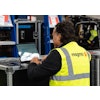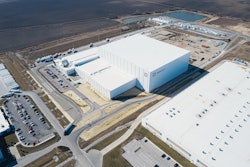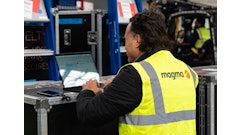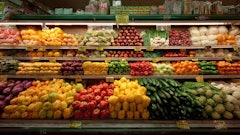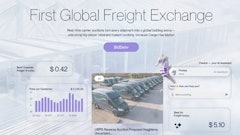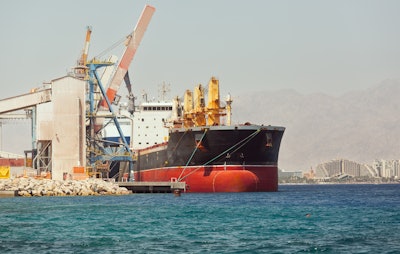
In just a few short months, the Red Sea transformed from one of the world’s most vital commercial arteries into a focal point of geopolitical tension.
The escalating conflict—involving the Houthis’ attacks on maritime traffic and international military responses—not only jeopardizes global trade, but also casts a shadow over the vulnerabilities surrounding the global food and beverage (F&B) supply chain.
It’s clear overcoming the disruption will require heightened visibility and temperature control to safely maintain the flow of goods, but a recent Tive study found that 47% of companies don’t have access to real-time technologies to monitor their shipments. There’s an urgent need for the F&B industry to embrace and expand the use of advanced tools, ensuring resilience and agility through tumultuous waters.
The Red Sea conflict and its strategic importance
The Red Sea’s significance for global trade is critical, with nearly 30% of global container traffic passing through the region.
This route's reliability is also pivotal for the smooth transportation of goods and raw materials in the F&B industry. Disruptions here directly impact brands’ ability to maintain efficient and cost-effective supply chains, causing everything from increased transit times and heightened security risks to the necessity for alternative routing strategies.
These challenges extend beyond mere logistics to encompass significant financial implications. Companies are grappling with the rising costs that come with detours and higher insurance pricing. Marine war risk premiums have seen a dramatic increase, soaring around fiftyfold since before the conflict began. Currently, these premiums can reach as high as 1% of the ship's value. For a ship carrying goods worth $100 million, this adjustment translates to an extra $700,000 for the brief passage through the Red Sea area.
Additionally, the unpredictability of shipping schedules threatens to upend the just-in-time delivery systems that many F&B businesses depend on, potentially leading to shortages or surpluses. And to top it off, ensuring product quality adds another layer of complexity, especially for perishable goods. Extended shipping times risk compromising both freshness and safety, necessitating innovative solutions to preserve the integrity of shipments.
How the F&B industry is responding
In response to the ongoing disruptions–from the Red Sea conflict and beyond–F&B businesses are adopting innovative strategies to ensure the continuity of their supply chains. The investment in real-time tracking technology, temperature logging, diversification of supply sources, and strategic rerouting are at the forefront of these efforts.
Investment in real-time shipment tracking. A critical adaptation for the F&B industry has been the significant investment in real-time shipment tracking technology. This technology provides companies with the ability to monitor their shipments closely, offering instant updates on location and status. In situations where shipments are at risk due to geopolitical tensions, real-time alerts enable companies to take swift action—such as rerouting shipments or implementing protective measures—to mitigate potential disruptions.
The real-time nature of these alerts means that companies are informed without delay, allowing for swift action to mitigate the situation. Depending on the nature of the alert—be it theft, damage, or deviation from required temperature conditions—logistics teams can deploy tailored solutions to address the problem, leveraging their expertise to minimize potential losses and ensure the safety of the goods.
Importance of temperature logging. Temperature logging is especially vital for the transportation of perishable goods such as fruits, vegetables, dairy, and meat. This technology ensures the maintenance of appropriate conditions throughout the transport process, crucial for preserving product quality and safety. Real-time alerts on temperature deviations allow for immediate interventions to avoid spoilage—a concern that becomes even more pronounced for shipments that might face extended journey times.
Diversifying the supply chain. To mitigate the impact of specific geopolitical unrest and supply chain vulnerabilities, F&B organizations are expanding their networks of suppliers and logistic partners. This strategic diversification reduces reliance on any single route or source, enhancing the resilience of the supply chain against a backdrop of geopolitical tensions and ensuring a more stable product delivery to consumers.
Navigating around Africa: A last resort. Given the heightened risks and operational costs associated with the Red Sea, some ships are now navigating all the way around Africa to reach European markets. This detour not only jeopardizes the freshness of perishable goods due to significantly increased shipment times, but also adds substantial fuel and operational costs. Such extended routes underscore the importance of real-time tracking and temperature monitoring technologies in ensuring that even under these challenging conditions, the integrity of shipments is maintained and products arrive in optimal condition.
Navigating future disruptions
The adoption of real-time shipment tracking and temperature logging reflects a broader trend around building resilience and adaptability within F&B supply chains. They not only provide immediate solutions to current logistical challenges, but also prepare businesses to more effectively face future disruptions, ensuring the ongoing delivery of safe, high-quality products to consumers no matter the hurdle.



